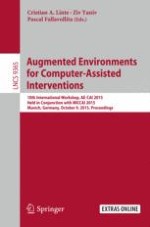2015 | Buch
Augmented Environments for Computer-Assisted Interventions
10th International Workshop, AE-CAI 2015, Held in Conjunction with MICCAI 2015, Munich, Germany, October 9, 2015. Proceedings
herausgegeben von: Cristian A Linte, Ziv Yaniv, Pascal Fallavollita
Verlag: Springer International Publishing
Buchreihe : Lecture Notes in Computer Science
